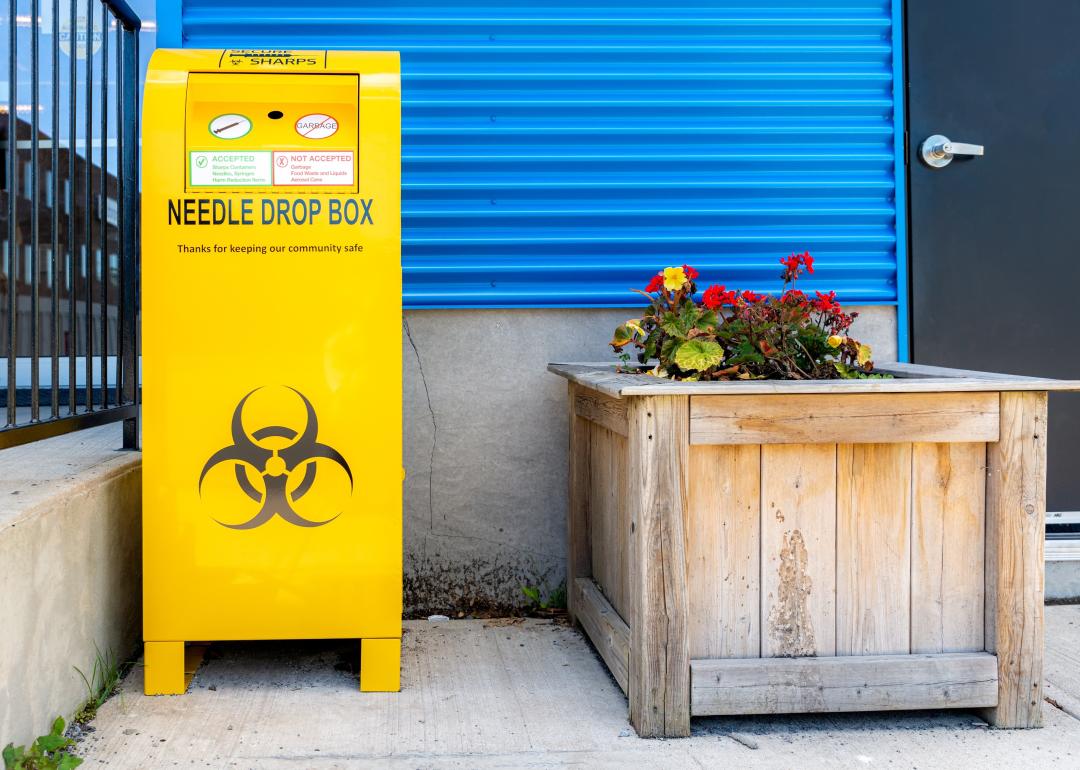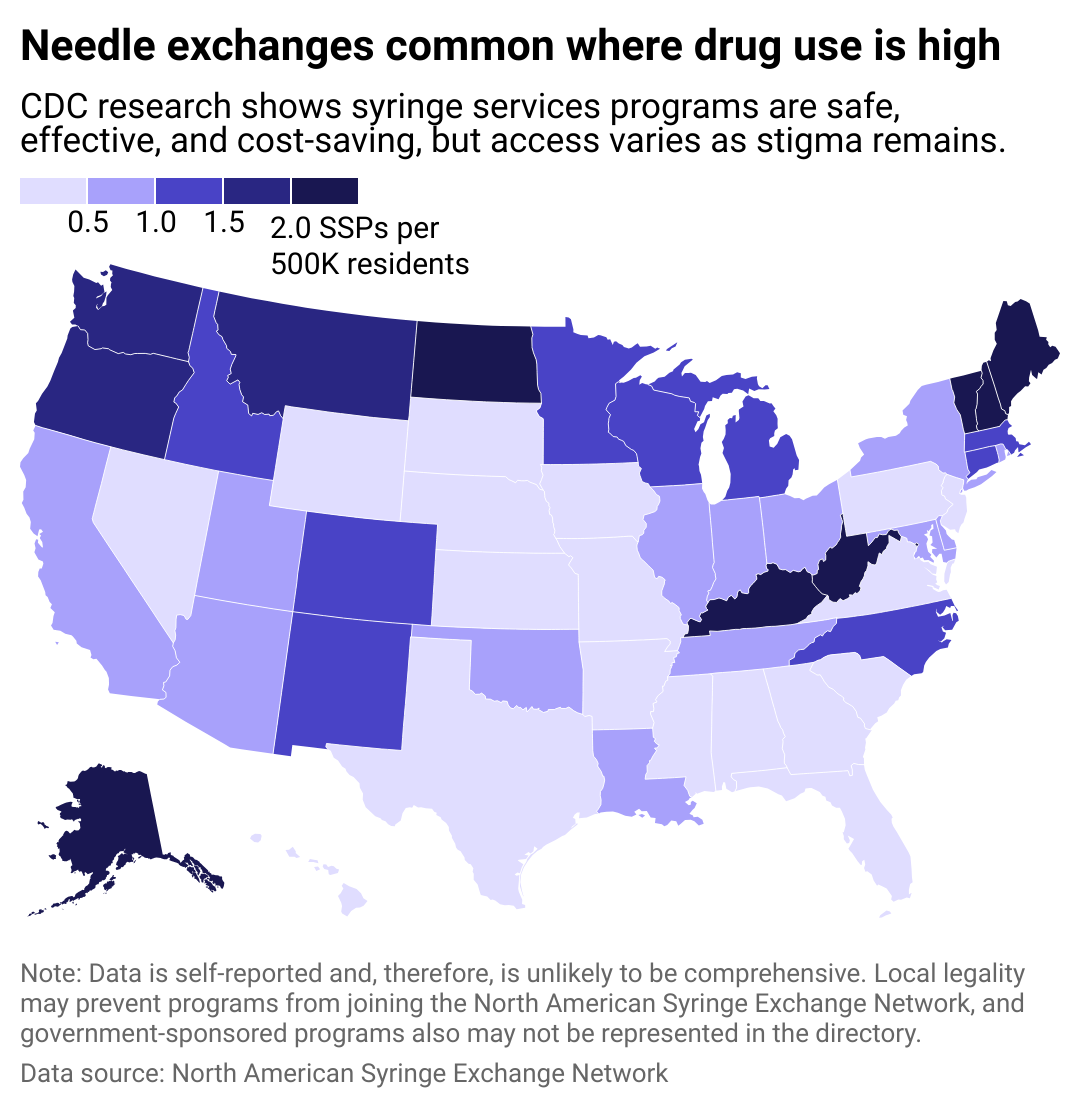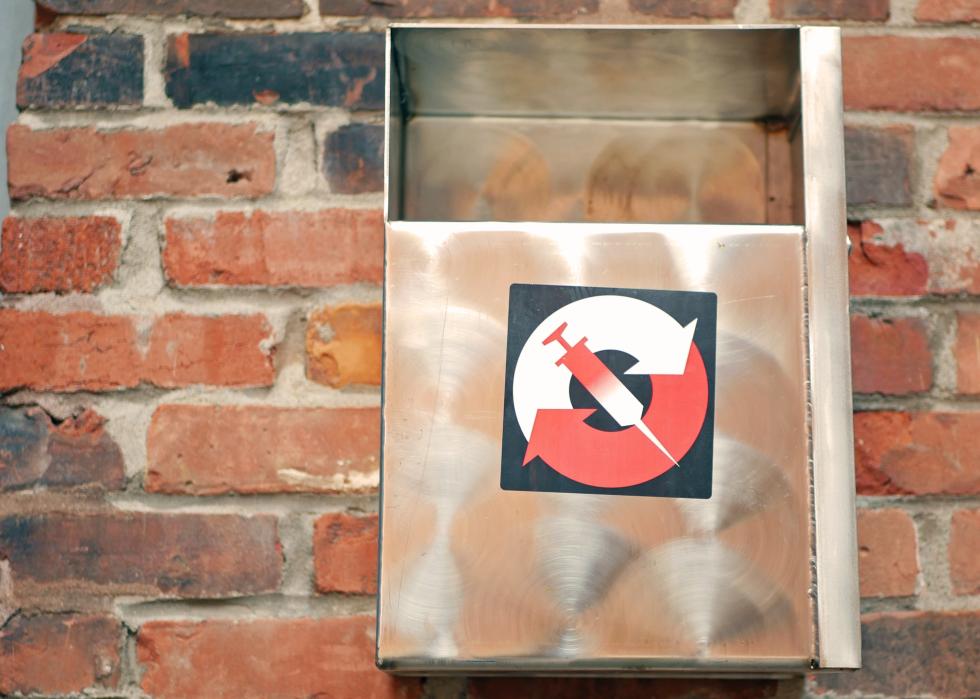
How syringe exchanges in California reduce the spread of disease
This story originally appeared on Ophelia and was produced and distributed in partnership with Stacker Studio.
How syringe exchanges in California reduce the spread of disease
In March 2024, Oregon quashed its efforts to decriminalize illicit drugs, which would have been the first of such laws in the nation, but the debate on how to curb the growing drug overdose epidemic in the United States rages on.
More than 100,000 Americans died from a drug overdose in the 12 months leading up to October 2023, according to the latest data from the Centers for Disease Control and Prevention. However, nearly two-thirds (64.7%) had a potential opportunity for intervention at least once, such as the presence of a bystander, a mental health condition, or a previous nonfatal overdose.
Syringe services programs are one of the provenly effective methods for decreasing overdose deaths as well as the spread of infectious diseases like HIV and Hepatitis C. SSPs are operated by community-based prevention programs that can offer other services such as testing, counseling, and medical treatment/wound care.
Ophelia examined data from the North American Syringe Exchange Network to determine which states have the most syringe services programs per capita. The number of programs in this analysis are self-reported to NASEN and are therefore unlikely to be comprehensive. For example, Kentucky had 32 SSPs in the database, but the state's Cabinet for Health and Family Services reported 84 operational sites as of June 2023. Five states (Kansas, Mississippi, Nebraska, South Dakota, and Wyoming) had no exchanges listed.
Syringe exchange nonprofits typically receive federal funding, state funding, and grants. CDC research has found that syringe services programs reduce overdose deaths and crime, as well as the spread of discarded needles in public areas like parks. However, the stigma of substance use disorder and NIMBYism—the "not-in-my-backyard" mentality—have created obstacles to passing potentially lifesaving legislation.

Syringe exchange access varies by state
Despite the lifesaving potential of these kinds of programs, syringe exchanges were federally banned at the national level from 1988 to 2015. A study published in the International Journal on Drug Policy attributes the end of the ban to shifting perspectives and lessons learned during the HIV/AIDS epidemic.
The rise of HIV infection related to the growth of the opioid epidemic in the early 2010s was powerful enough to sway politicians who had been reluctant to embrace syringe exchanges. States in the years since passed their own laws to create exchange programs. Most recently, a bill authorizing community syringe exchanges passed in the Nebraska Legislature but was ultimately vetoed by Gov. Jim Pillen.
Syringe exchanges in California include:
Any Positive Change Inc
Lower Lake, California
Asian American Drug Abuse Program Inc
Inglewood, California
ASN Syringe Services Program
Salinas, California
Being Alive Los Angeles
Los Angeles, California
Berkeley Free Clinic
Berkeley, California
Bienestar
Los Angeles, California
Clean Needles Now
Los Angeles, California
Common Ground Syringe Exchange
Venice, California
DAP Health Harm Reduction Program
Palm Springs, California
Face to Face
Santa Rosa, California
Fresno Needle Exchange Program
Fresno, California
Gender Health Center's Syringe Exchange
Sacramento, California
Glide Syringe Access Services (SAS)
San Francisco, California
Harm Reduction Circle - Irvine
Irvine, California
Harm Reduction Coalition of Santa Cruz County
Santa Cruz, California
Harm Reduction Institute (HRI)
Santa Ana, California
Highland Hospital Emergency Department and Bridge Clinic
Oakland, California
Homeless Health Care Los Angeles
Los Angeles, California
Hope in the Valley
Bakersfield, California
Humboldt Area Center for Harm Reduction
Arcata, California
Inland Empire Harm Reduction
Riverside, California
Kings County Syringe Exchange Program
Hanford, California
LIHC SSP
Susanville, California
MCAVHN Care & Prevention Network
Ukiah, California
Mono County Harm Reduction Program
Mammoth Lakes, California
NEED
Berkeley, California
Neighborhood Healthcare Harm Reduction Program
Escondido, California
NEXT Distro - CA
, California
North Coast AIDS Project
Eureka, California
Northern Sierra Harm Reduction
Quincy, California
Northern Valley Harm Reduction Coalition
Chico, California
ON POINT
San Diego, California
Pacific Pride Foundation
Santa Barbara, California
Punks with Lunch
Oakland, California
Safe Point San Diego
San Diego, California
Safe Points Syringe Exchange
Sacramento, California
Safer Alternatives thru Networking & Education
Sacramento, California
San Francisco AIDS Foundation
San Francisco, California
San Francisco Veterans Affairs Health Care System Harm Reduction & Syringe Services Program
San Francisco, California
Santa Clara County Harm Reduction Program
San Jose, California
Santa Cruz County Syringe Services Program
SANTA CRUZ, California
SHARPS Center Point-DAAC
Santa Rosa, California
Shasta County Syringe Services Program
Redding, California
Sierra County Harm Reduction
Loyalton, California
Sierra Harm Reduction Coalition
Placerville, California
SLO Bangers Syringe Exchange
San Luis Obispo, California
Stockton Harm Reduction Program
Stockton, California
The Exchange Bakersfield
Bakersfield, California
The HIV Education and Prevention Project of Alameda County
Oakland, California
The Sidewalk Project
Los Angeles, California
The Spahr Center
San Rafael, California
Trans:Thrive
San Francisco, California
TTC Syringe Services Program
Reseda, California
Valley Streetz
Modesto, California
Ventura County Syringe Replacement Program VC-SRP
Oxnard, California

Benefits and risks of needle exchange programs
Critics often argue that needle exchanges promote drug use at the expense of taxpayer dollars, or that they feel unsafe around the people with substance use disorder that use them.
Research conducted over three decades, however, shows that syringe exchange programs provide a benefit to communities, according to the National Institutes of Health.
A 2019 study from the National Bureau of Economic Research found that syringe exchange programs reduced HIV diagnoses by as much as 18%. They've also been shown to save taxpayers money. In Indiana, a state-implemented syringe exchange program is expected to save taxpayers $120 million. People who use syringe service programs are also five times more likely to begin a drug treatment program and three times as likely to quit injection drug abuse, according to the CDC.
This story features data reporting by Elena Cox, writing by Dom DiFurio, and is part of a series utilizing data automation across 46 states.



